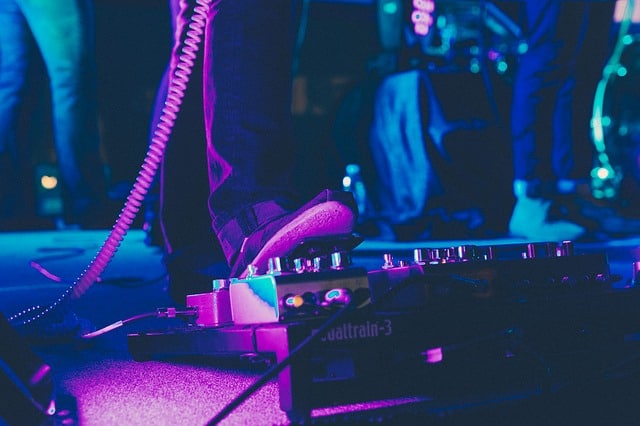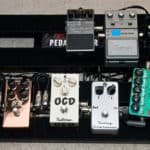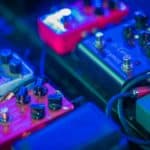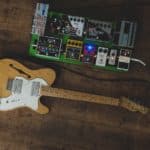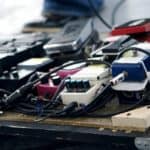Noise gates are a must-have piece of gear if most of your tones rely on heavy distortion.
However, deciding on where to put them on your signal chain might not be as straightforward as you think.
In addition to this, compressor pedals also are the object of lots of discussion about where they should be placed for optimal performance.
Now, combining these 2 types of pedals in a pedalboard might require some trial and error until you find their sweet spot.
But based on most players’ experience: Should you put your noise gate before or after a compressor pedal?
The common consensus among players is to put the noise gate first and then use a compressor. The reason behind this is that by doing the opposite the compressor will raise the noise floor and then the gate will have to be set up with a higher threshold that might cause some quieter notes to be lost.
In this article, I will tell you all you need to know about how compressors and noise gates work by themselves and when put together.
After leaving this page, you will know exactly what things you should take into consideration for combining these pedals, and what is the optimal order for them.
Are you ready to get started?
Let’s go!
How does a noise gate work?
At a very basic level, noise gates work by just cutting off any audio signal that’s lower in volume than a certain threshold.
That threshold is defined by the player and is one of the most important settings to define.
But also, you could tweak how hard or steep will the cutoff be, among other things.
Noise gates are fundamental for many music genres where gear is pushed to the limit and noise becomes something you really need to deal with.
Think of metal and very aggressive distortion.
The downside is that excessive use of noise gates by dialing very heavy settings might end up affecting the overall tone, and even the sustain of your rig.
How does a compressor work?
Compressors in audio are tools that work with the dynamic range of the signal.
What a compressor does is take an audio wave, analyze its peaks and valleys, and cut those high points at a certain level.
By chopping the highest volume parts of a signal you end up with less range, in volume, between the quieter parts and the louder ones.
This, ultimately, allows for the player or mixer to increase the volume of the overall clip since there are no peaks to deal with.
But also, this is a very common effect used to even out rhythm playing, for instance in clean tones.
Think of a funk player and the need for their lines to sound constant and homogeneous.
What’s the difference between a noise gate and a compressor?
The main difference between a noise gate and a compressor is that they work in opposite directions if you think about it.
While a noise gate cuts off signals below a certain dB threshold, compressors squash down signals above a certain threshold.
They are completely different audio tools, and one can’t replace the other in any way.
Why should you put your noise gate before a compressor?
The reason why you would probably want to gate your audio first, and then compress it is that if you were to do the opposite, you will be raising the noise floor, and then needing to define a higher threshold for the gate to work properly.
You see, if you first compress the signal, you will end up with a smaller dynamic range separating the background noise from your loudest notes, since the latter gets slammed down whenever they peak.
The resulting signal will be indeed more even, but it will be harder to distinguish noise from actual guitar sound.
You will require to set the noise gate to cut off at a level where some of the quieter notes might be confused with noise.
So, remember, always work on leaving the noise out, so then you can focus on making your quieter and louder playing closer together in volume.
Are there any reasons to put the compressor in front?
There is no real point in running your compressor in front of a noise gate because you will end up making the noise on your signal relatively louder, and having to set up the threshold of the gate higher.
However, if your rig is actually not that noisy, you might experiment with different pedal positions on the chain.
Perhaps you figure out a way to make them sound better to you.
I’ve heard of players that prefer having compression first since it evens out everything, and then having the gate work from there.
I don’t really agree with that but to each their own.
After all, the tone is just a small part of music, and there are no rules for any of it.
Just try out different things, decide with your ears, and don’t stress over what’s not important.
Should you run these effects in front of the amp or through the FX loop?
There are different places where you could or should place your compressor and noise gate.
To begin with, noise gates are intended to eliminate as much unwanted clatter from your signal as possible, and they have to be placed just after the element that’s generating it.
So, if the noise comes from your overdrive, fuzz, or distortion pedal, just put your gate after now.
Now, if the buzz is being generated by your amp’s preamp stage, it would be wise to use your noise gate in the effects loop.
Compressors also have alternative placements, depending on the player’s preference.
Usually, for tidying up clean tones, players choose to put their compressors in front of their whole rig, so the sound gets evened up before it hits any other effects.
When working with distortion pedals, it’s common to leave compressors off, since overdrive circuits add their own compression.
The drawback of using compression early in the signal chain is that you lose responsiveness from your guitar’s volume control.
For players that like tweaking how hard the guitar output hits the amp regularly, a compressor through the effects loop will allow them to do so, while still providing a subtle effect, closer to what a mixing engineer would achieve when working with the finished signal.

Hello there, my name is Ramiro and I’ve been playing guitar for almost 20 years. I’m obsessed with everything gear-related and I thought it might be worth sharing it. From guitars, pedals, amps, and synths to studio gear and production tips, I hope you find what I post here useful, and I’ll try my best to keep it entertaining also.

